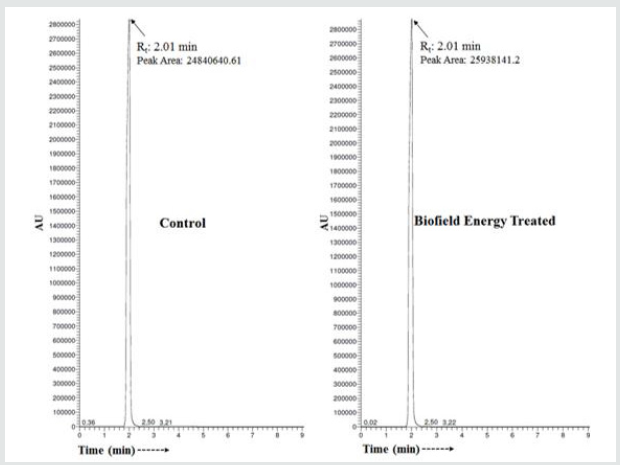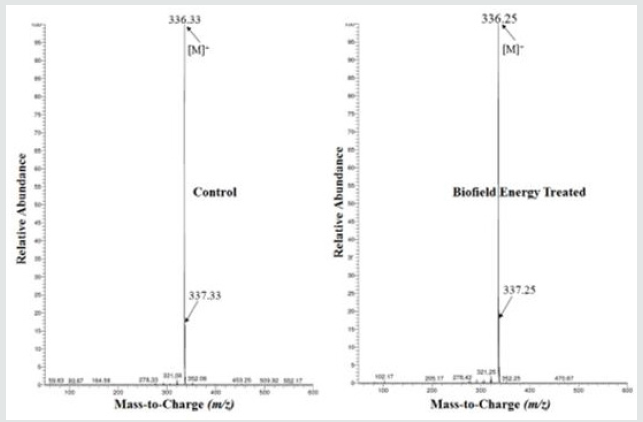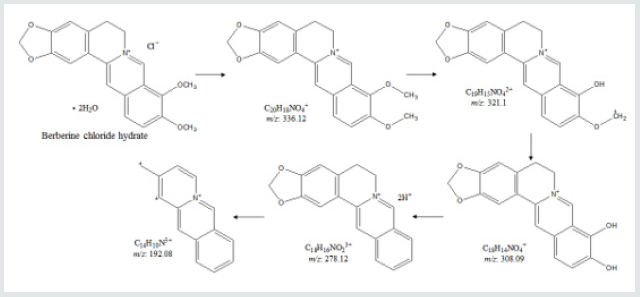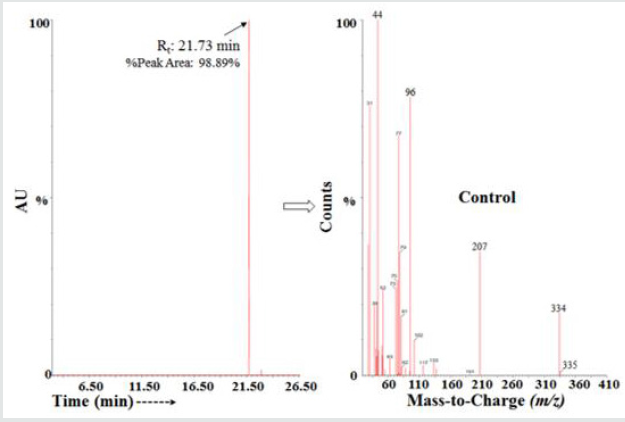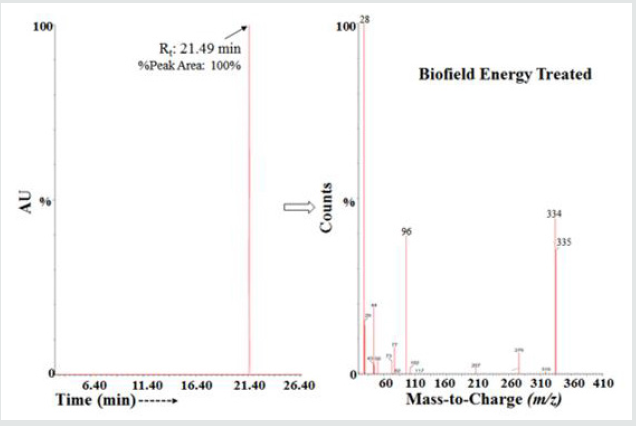
Lupine Publishers Group
Lupine Publishers
Menu
ISSN: 2644-1217
Research ArticleOpen Access
A Comprehensive Study of Isotopic Abundance Ratio Analysis of the Consciousness Energy Healing Treated Berberine Chloride Using LC-MS and GC-MS Volume 3 - Issue 1
Mahendra Kumar Trivedi1, Alice Branton1, Dahryn Trivedi1 and Snehasis Jana2*
- 1Trivedi Global, Inc., Henderson, USA
- 2Trivedi Science Research Laboratory Pvt. Ltd., India
Received: February 05, 2021 Published: March 03, 2021
*Corresponding author: Snehasis Jana, Trivedi Science Research Laboratory Pvt. Ltd., India
Abstract
Berberine is an alkaloid class of drug which has enormous therapeutic potential, but the bioavailability is very poor (<1%) due to its low solubility and poor intestinal absorption. In this study, the influence of the Trivedi Effect® on the structural properties and the isotopic abundance ratio of berberine chloride was evaluated using LC-MS and GC-MS analytical techniques. Berberine chloride sample was divided into control and treated parts. Only the treated part was received the Trivedi Effect®-Consciousness Energy Healing Treatment remotely by a well-known Biofield Energy Healer, Mahendra Kumar Trivedi. The LC-MS spectra of both the samples observed at retention time 2.0 minutes and the molecular ion peak at m/z 336.25 [M]+ in the mass spectra. The peak area of the treated berberine was significantly increased by 4.42% compared to the control sample. The LC-MS based isotopic abundance ratio of PM+1/PMin the treated berberine was significantly increased by 34.4% compared with the control sample. Similarly, the GC-MS based isotopic abundance ratio of PM+1/PM in the treated berberine was very increased by 1547.15% compared with the control sample. Thus,13C, 2H, 15N, and17O contributions from (C20H18NO4)+ to m/z 337 in the treated sample were significantly increased compared with the control sample. The isotopic abundance ratio of PM+1/PM (2H/1H or 13C/12C or 15N/14N or 17O/16O) in the treated berberine was significantly altered compared to the control sample. The increased isotopic abundance might occur due to the interference of neutrino particles via the Trivedi Effect®-Consciousness Energy Healing Treatment. The increased isotopic abundance ratio of the Consciousness Energy Healing Treated berberine chloride may increase the chemical bond strength, stability, solubility, and bioavailability in the body. The new form of berberine chloride would be more efficacious novel pharmaceutical formulations against diarrhoea, gastroenteritis, bacterial and fungal infections, cancer, diabetes, arrhythmia, inflammation, hyperlipidemia, etc.
Introduction
Berberine is an alkaloid class of drug, extracted from the plant sources, i.e., Mahonia aquifolium, Hydrastis Canadensis, Coptis chinensis,Berberis vulgaris, etc. [1,2]. Mainly it has been used as a natural dye from the old age. It is also used for the treatment of diarrhoea, gastroenteritis, cancer, arrhythmia, diabetes, bacterial, fungal, and other microbial infections, hyperlipidemia, inflammation, etc. [3-13]. Similarly, berberine also has anti-glycaemic and anti-aging properties [14]. Many biological activities of berberine with less toxicity and low cost made it a great interesting candidate for the treatment of human diseases [15-18]. The poor bioavailability of the berberine is due to its low solubility, poor intestinal absorption, and rapid biotransformation also account for the low plasma concentrations [19,20]. The bioavailability of the berberine is very poor (<1%), which is the big challenge to develop it as a clinical candidate.
The improvement of bioavailability is a challenging task, but many types of research are going on for the improvement in berberine [21]. The Trivedi Effect®-Consciousness Energy Healing Treatment proved to have a significant impact on the particle size, surface area, crystal properties, thermal behaviour, along with bioavailability of the pharmaceutical/nutraceutical compounds [22-25]. The Trivedi Effect® is a natural and only scientifically proven phenomenon in which a Biofield Energy expert can harness this energy from the Universe and transfer it anywhere on the planet via the possible mediation of neutrinos [26]. The Biofield is an electromagnetic field that exists around the human body generated by continues moment of the charged particles and movements in the body, i.e., particles, ions, cells, blood/lymph flow, brain functions, and heart function [25,27]. The use of energy therapy has been studied and reported with significant outcomes in different disease conditions [28,29]. The mechanism involved in the Biofield Energy Healing Treatment process is the energy harness from the universe by the healer and transfer the energy to any living and non-living object(s) for the wellness [30,31]. The National Center of Complementary and Integrative Health (NCCIH) has recognized and accepted Energy Therapy as a Complementary and Alternative Medicine (CAM) health care approach along with the other therapies, medicines, and practices, i.e., Ayurveda, Chinese herb and traditional medicine, homeopathy, Qi Gong, Tai Chi, yoga, Reiki, hypnotherapy, etc. [32]. These CAM therapies have been accepted by most of the USA people [33]. The Trivedi Effect®also reported having a significant impact on the characteristic properties of the several living and non-living object(s), i.e., organic compounds, ceramic, metals, cancer cell lines, crops, microbes [34-39] etc.
The Trivedi Effect®-Consciousness Energy Healing Treatment also has the isotopic abundance ratio analysis [34, 40, 41]. The analysis of stable isotope ratio has various applications for the understanding of isotope effects resulting from the variation of the isotopic composition of the molecule [34, 42].Isotope ratio analysis generally performed by using the conventional mass spectrometry techniques, i.e., gas chromatography-mass spectrometry (GC-MS) and liquid chromatography-mass spectrometry (LC-MS), which can detect the low micromolar concentration with sufficient precision [42, 43]. Thus, in this study, the LC-MS and GC-MS analytical techniques were used to characterize the structural properties and evaluate the isotopic abundance ratio in the Treated berberine chloride compared with the control sample.
Materials and Methods
Chemicals and Reagents
The test compound berberine chloride hydrate (98.1% HPLC) was purchased from Tokyo Chemical Industry Co. Ltd., Japan, and other HPLC grade reagents like acetonitrile and formic acid were purchased from Merk, India.
ConsciousnessEnergy Healing Treatment Strategies
The test sample berberine chloride was divided into two parts and termed as control and treated sample based on the type of treatment. One part of the berberine chloride was received the Trivedi Effect®-Consciousness Energy Healing Treatment under standard laboratory conditions by the renowned Biofield Energy Healer, Mahendra Kumar Trivedi, USA, known as the Biofield Energy Treated sample for 3 minutes. The other part of the sample did not receive the Biofield Energy Treatment but was treated with a “sham” healer who did not have any knowledge about the Biofield Energy Treatment. After the treatment, both the samples were kept in sealed conditions and characterized using LC-MS and GC-MS analytical techniques.
Characterization
Liquid Chromatography-Mass Spectrometry (LC-MS) Analysisand Calculation ofIsotopic Abundance Ratio
The LC-MS analysis of both the sample was performed with the
help of LC-MS ThermoFisher Scientific, the USA, connected with an
ion trap detector and triple-stage quadrupole mass spectrometer. A
reversed phase Thermo Scientific Synchronis C18 (Length-250 mm
X ID 4.6 mm X 5 micron) column was used (35°C). Acetonitrile and
methanol were used as diluent for the sample preparation. 5 μL of
berberine chloride solution was injected, and the analyte was eluted
using acetonitrile + 0.1% formic acid (50:50) pumped at a constant
flow rate of 1 mL/min in gradient condition (total run time 10 min).
Peaks were monitored at 210 nm using the PDA detector. The mass
spectrometric analysis was performed in +ve ESI mode.
The natural abundance of each isotope (C,H,N, and O) can be
predicted from the comparison of the height of the isotope peak
with respect to the base peak. The values of the natural isotopic
abundance of the common elements are obtained from the
literature [40,44-46]. The LC-MS based isotopic abundance ratio
(PM+1/PM) for the control and treated berberine was calculated using
equation (1).
(%) Change in isotopic abundance ratio = [(IARTreated – IARControl)/ IARControl)]x 100 (1)
Where IARTreated = isotopic abundance ratio in the treated sample and IARControl= isotopic abundance ratio in the control sample.
Gas Chromatography-Mass Spectrometry (GC-MS) Analysis
GC-MS of both the samples was analyzed with the help of Perkin Elmer GC equipped with a PE-5MS (30M x 250 micros x 0.250 microns) capillary column and coupled to a single quadrupole mass detector was operated with electron impact (EI) ionization (+ve mode). The oven temperature was from 75°C (5 min hold) to 280°C (14.5 min hold) @ 10°C /min (total run time 40 min). The sample was prepared taking 50 mg of the berberine chloride in 2.5 ml methanol as a diluent. The change in the GC-MS based isotopic abundance ratio (PM+1/PM) of the treated berberine chloride was calculated compared to the control sample using equation (1).
Results and Discussion
Liquid Chromatography-Mass Spectrometry (LC-MS)
The chromatograms of both the samples of berberine chloride showed a single major chromatographic peak at retention time (Rt) of ~2 minutes (Figure1). The peak area of the Biofield Energy Treated berberine was significantly increased by 4.42% compared to the control sample. This indicated that the solubility of treated berberine was significantly increased, which may improve the bioavailability of berberine compared to the control sample. The mass spectra of berberine exhibited the mass of the molecular ion peak at m/z 336.3 [M]+ (calculated for C20H18NO4+, 336.12) along with other fragmentation peak at 321 (C19H15NO42+) in both the spectra (Figures 2&3). The mass spectra of berberine show the molecular peak [M]+ at m/z 336.3 in the mass spectrum [47].
The LC-MS spectra of both the samples showed the mass of the molecular ion peak at m/z336.3 [M]+ (calculated for C20H18NO4+, 336.12) with 100% relative intensity. The theoretical calculation of PM+1for berberine was presented as below:
P(13C) = [(20 x 1.1%) x 100% (the actual size of the M- peak)] / 100% = 22%
P(2H) = [(18 x 0.015%) x 100%] / 100%= 0.27%
P(15N) = [(1 x 0.4%) x 100%] / 100% = 0.4%
P(17O) = [(4 x 0.04%) x 100%] / 100% = 0.16%
PM+1,i.e.13C,2H, 15N, and 17O contributions from (C20H18NO4)+ to m/z 337 = 22.83%
From the above calculation, it has been found that 13C, and15N have the major contribution to m/z 337. Based on the LC-MS data, the isotopic abundance ratio analysis PM and PM+1nearm/z 336 [M+]and 337 [(M+1)+] of the control and treated berberine samples were evaluated(Table 1). The isotopic abundance ratio (PM+1/PM) in the treated berberine was significantly increased by 34.4% compared with the control sample (Table 1). Thus, it was concluded that the13C, 2H, 15N,and17O contributions from (C20H18NO4)+ tom/z337 in the Biofield Energy Treated berberine was significantly increased compared to the control sample.
Table 1: LC-MS based isotopic abundance analysis results in Biofield Energy Treated berberine compared to the control sample.

Gas Chromatography-Mass Spectrometry (GC-MS) Analysis
The control and treated berberine showed a sharp chromatographic peak at Rt 21.5 minutes in the chromatograms (Figures 4&5). The parent molecular ion peak of berberine at m/z334 [M]+ (calculated for C20H16NO43+, 334.11) was observed in both the samples, along with the lower mass fragment ion peaks (Figures 4&5).
The mass spectra of both the samples showed the molecular ion peak [M]+ at m/z334 [M]+ (calculated for C20H16NO43+, 334.11). The theoretical calculation of PM+1 and PM+2for berberine was presented as below:
P(13C) = [(20 x 1.1%) x 17.63% (the actual size of the M+ peak)] / 100% = 3.88%
P(2H) = [(16 x 0.015%) x 17.63%] / 100%= 0.04%
P(15N) = [(1 x 0.4%) x 17.63%] / 100% = 0.07%
P(17O) = [(4 x 0.04%) x 17.63%] / 100% = 0.03%
PM+1,i.e.13C, 2H, 15N, and17O contributions from (C20H16NO4)3+ tom/z 335 = 4.02%
From the above calculation, it has been found that 13C and 15N have major contribution to m/z335 and 336.
The GC-MS based isotopic abundance ratio analysis of the treated berberine was calculated compared to the control sample. PM, and PM+1for berberine near m/z 334 [M+] and335 [(M+1)+], respectively, of both the samples were calculated (Table 2). The isotopic abundance ratio of PM+1/PM in the treated berberine was very significantly increased by 1547.15% compared with the control sample (Table 2). Hence,13C, 2H, 15N, and 17O contributions from (C20H16NO4)3+ to m/z 335 in the treated sample were significantly increased compared with the control sample.
Table 2: GC-MS based isotopic abundance analysis results of Biofield Energy Treated berberine compared to the control samples.
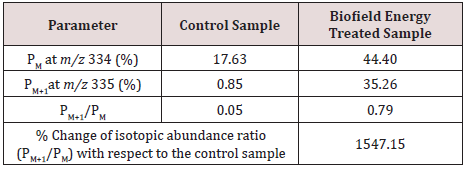
The structure of berberine was confirmed by chromatographic and spectroscopic study. The isotopic abundance ratio of PM+1/PM (2H/1H or 13C/12C or 15N/14N or 17O/16O) in the treated berberine was significantly altered compared to the control sample. The altered isotopic composition in the treated berberine might be due to the altered neutron to proton ratio in the nucleus via the interference of neutrino particles done by the Trivedi Effect®-Consciousness Energy Healing Treatment. Neutrino is an elementary particle that interacts via the weak subatomic force and gravity [48]. The neutrinos can change identities which specified a close relation between neutrino and the isotope formation [26 40,41]. The isotopic abundance ratio 2H/1H or 13C/12C or 15N/14N or 17O/16O would highly influence the atomic bond vibration and strength of the Biofield Energy Treated berberine chloride [49]. The increased isotopic abundance ratio (PM+1/PM) of the Consciousness Energy Healing Treated berberine chloride may significantly increase the chemical bond strength, improve its stability, solubility, and bioavailability in the body. The Trivedi Effect®-Consciousness Energy Healing Treatment might create a new form of berberine chloride, which would be better for the prevention and treatment of diarrhea, gastroenteritis, bacterial, fungal, and other microbial infections. It would be helpful for the treatment of cancer, arrhythmia, diabetes, hyperlipidemia, and inflammation also.
Conclusion
The Consciousness Energy Healing Treatment showed a significant impact on the isotopic abundance ratio of berberine chloride. The LC-MS spectra of both the samples observed at retention time 2.0 minutes and the molecular ion peak at m/z 336.25 [M]+ in the mass spectra. The peak area of the Biofield Energy Treated berberine was significantly increased by 4.42% compared to the control sample. The LC-MS based isotopic abundance ratio of PM+1/PM in the Biofield Energy Treated berberine was significantly increased by 34.4% compared with the control sample. Similarly, the GC-MS based isotopic abundance ratio of PM+1/PM in the Biofield Energy Treated berberine was very increased by 1547.15% compared with the control sample. Thus,13C, 2H, 15N, and 17O contributions to m/z 337 in the Biofield Energy Treated sample were significantly increased compared with the control sample. The isotopic abundance ratio of PM+1/PM (2H/1H or 13C/12C or 15N/14N or 17O/16O) in the Biofield Energy Treated berberine was significantly altered compared to the control sample. The increased isotopic abundance might occur due to the interference of neutrino particles via the Trivedi Effect®-Consciousness Energy Healing Treatment. The increased isotopic abundance ratio of the Consciousness Energy Healing Treated berberine chloride may increase the chemical bond strength, stability, solubility, and bioavailability in the body. The new form of berberine chloride would be more efficacious novel pharmaceutical formulations against diarrhoea, gastroenteritis, bacterial and fungal infections, cancer, diabetes, arrhythmia, inflammation, hyperlipidemia, etc.
Acknowledgements
The authors are grateful to Sophisticated Instrumentation Centre for Applied Research & Testing (SICART) India, Trivedi Science, Trivedi Global, Inc., and Trivedi Master Wellness for their assistance and support during this work.
References
- https://en.wikipedia.org/wiki/Berberine.
- Inbaraj JJ, Kukielczak B, Bilski P, Sandvik S, Chignell C (2001) Photochemistry and photocytotoxicity of alkaloids from Goldenseal (Hydrastis canadensis L.) Chem Res Toxicol 14(11): 1529-1534.
- Tang J, Feng Y, Tsao S, Wang N, Curtain R, et al. (2009) Berberine and Coptidisrhizoma as novel antineoplastic agents: A review of traditional use and biomedical investigations. J Ethnopharmacol 126(1): 5-17.
- Gulrajani ML (2001) Present status of natural dyes. Indian J Fibre Text Res 26: 191-201.
- Singh A, Duggal S, Kaur N, Singh J (2010) Berberine alkaloid with wide spectrum of pharmacological activities. J Nat Prod 3: 64-75.
- Chen C, Yu Z, Li Y, Fichna J, Storr M (2014) Effects of Berberine in the gastrointestinal tract -A review of actions and therapeutic implications. Am J Chin Med 42: 1053-1070.
- Stermitz FR, Lorenz P, Tawara JN, Zenewicz LA, Lewis K (2000) Synergy in a medicinal plant: Antimicrobial action of Berberine potentiated by 50 -methoxyhydnocarpin, a multidrug pump inhibitor. Proc Natl Acad Sci, USA 97: 1433-1437.
- Stermitz FR, Lorenz P, Tawara JN, Zenewicz LA, Lewis K (2000) Synergy in a medicinal plant: Antimicrobial action of berberine potentiated by 5'-methoxyhydnocarpin, a multidrug pump inhibitor. Proceedings of the National Academy of Sciences of the United States of America 97(4): 1433-1437.
- Diogo CV, Machado NG, Barbosa IA, Serafim TL, Burgeiro A, et al. (2011) Berberine as a promising safe anti-cancer agent - is there a role for mitochondria?. Curr Drug Targets 12(6): 850-859.
- Xia LM, Luo MH (2015) Study progress of berberine for treating cardiovascular disease. Chronic Dis Transl Med 1(4): 231-235.
- Dong H, Wang N, Zhao L, Lu F (2012) Berberine in the treatment of type 2 diabetes mellitus: A systemic review and meta-analysis. Evid Based Complement Alternat Med 2012: 591654.
- Dong H, Zhao Y, Zhao L, Lu F (2013) The effects of berberine on blood lipids: A systemic review and meta-analysis of randomized controlled trials. Planta Med 79(6): 437-446.
- Mohan MC, Abhimannue AP, Kumar BP (2017) Identification and characterization of berberine in Tinospora cordifolia by liquid chromatography quadrupole time of flight mass spectrometry (LC MS/MS Q-tof) and evaluation of its anti-inflammatory potential. Pharmacognosy Journal 9(3): 350-355.
- Zhao H, Halicka HD, Li J, Darzynkiewicz Z (2013) Berberine suppresses gero-conversion from cell cycle arrest to senescence. Aging (Albany NY) 5(8): 623-636.
- Brusq JM, Ancellin N, Grondin P, Guillard R, Martin S, et al. (2006) Inhibition of lipid synthesis through activation of AMP kinase: An additional mechanism for the hypolipidemic effects of berberine. Journal of Lipid Research 47(6): 1281-1288.
- Zhou XQ, Zeng XN, Kong H, Sun XL (2008) Neuroprotective effects of berberine on stroke models in vitro and in vivo. Neurosci Lett 447(1): 31-36.
- Abd El-Wahab AE, Ghareeb DA, Sarhan EE, Abu-Serie MM, El Demellawy MA (2013) In vitro biological assessment of berberis vulgaris and its active constituent, berberine: Antioxidants, anti-acetylcholinesterase, anti-diabetic and anticancer effects. BMC Complement Altern Med 13: 218.
- Zeng XH, Zeng XJ, Li YY (2003) Efficacy and safety of berberine for congestive heart failure secondary to ischemic or idiopathic dilated cardiomyopathy. Am J Cardiol 92(2): 173-176.
- Liu YT, Hao HP, Xie HG, Lai L, Wang Q, et al. (2010) Extensive intestinal first-pass elimination and predominant hepatic distribution of berberine explain its low plasma levels in rats. Drug MetabDispos 38(10): 1779-1784.
- Gupta PK, Hubbard M, Gurley B, Hendrickson HP (2009) Validation of a liquid chromatography-tandem mass spectrometric assay for the quantitative determination of hydrastine and berberine in human serum. J Pharm Biomed Anal 49(4): 1021-1026.
- Chen W, Miao Y, Fan DJ, Meng L, Yang S, et al. (2012) Bioavailability study of berberine and the enhancing effects of TPGS on intestinal absorption in rats. Drug Dev Ind Pharm 12(2): 705-711.
- Branton A, Trivedi MK, Trivedi D, Nayak G (2019) Study of the effect of consciousness energy healing treatment on the natural product berberine chloride. Int J Pharmacogn Chinese Med 3(1): 000153.
- Branton A, Trivedi MK, Trivedi D, Nayak G (2019) Evaluation of the physicochemical and thermal properties of consciousness energy healing treated cefazolin sodium. Organic & Medicinal Chem IJ 8(3): 555738.
- Branton A, Trivedi MK, Trivedi D, Nayak G (2019) Complementary and alternative medicine: evaluation of the physicochemical and thermal properties of the biofield energy treated metronidazole. Glob J Pharmaceu Sci 7(2): 62-69.
- Branton A, Jana S (2017) The influence of energy of consciousness healing treatment on low bioavailable resveratrol in male Sprague Dawley rats. International Journal of Clinical and Developmental Anatomy 3(3): 9-15.
- Trivedi MK, Mohan TRR (2016) Biofield energy signals, energy transmission and neutrinos. American Journal of Modern Physics 5(6): 172-176.
- Movaffaghi Z, Farsi M (2009) Biofield therapies: Biophysical basis and biological regulations. Complement Ther Clin Pract 15(1): 35-37.
- Rubik B, Muehsam D, Hammerschlag R, Jain S (2015) Biofield science and healing: History, terminology, and concepts. Glob Adv Health Med 4: 8-14.
- Shenefelt PD (2014) Energy medicine in dermatology. In: Norman RA, Shenefelt PD, Rupani RN, editors. Integrative Dermatology.Oxford University Press, New York, NY, USA.
- Rubik B (2002) The biofield hypothesis: Its biophysical basis and role in medicine. J Altern Complement Med 8(6): 703-717.
- Nemeth L (2008) Energy and biofield therapies in practice. Beginnings 28(3): 4-5.
- Koithan M (2009) Introducing complementary and alternative therapies. J Nurse Pract 5(1): 18-20.
- Barnes PM, Bloom B, Nahin RL (2008) Complementary and alternative medicine use among adults and children: United States, 2007. Natl Health Stat Report 12: 1-23.
- Trivedi MK, Branton A, Trivedi D, Nayak G, Panda P, et al. (2016) Evaluation of the isotopic abundance ratio in biofield energy treated resorcinol using gas chromatography-mass spectrometry technique. Pharm Anal Acta 7(5): 481.
- Nayak G, Trivedi MK, Branton A, Trivedi D, Jana S (2018) The physicochemical and thermal properties of consciousness energy healing treated silver oxide (Ag2O). Aspects in Mining & Mineral Science 2(3): 1-6.
- Dahryn T, Mahendra Kumar T, Alice B, Gopal N, Snehasis J (2019) Evaluation of the physicochemical and thermal properties of antimony: Influence of the energy of consciousness healing treatment. Op Acc J Bio Eng& Bio Sci 3(3): 303-309.
- Trivedi MK, Patil S, Shettigar H, Mondal SC, Jana S (2015) The potential impact of biofield treatment on human brain tumor cells: A time-lapse video microscopy. J Integr Oncol 4(3): 141.
- Trivedi MK, Branton A, Trivedi D, Shettigar H, Nayak G, et al. (2015) Assessment of antibiogram of multidrug-resistant isolates of Enterobacter aerogenes after biofield energy treatment. J Pharma Care Health Sys 2(5): 145.
- Trivedi MK, Branton A, Trivedi D, Nayak G, Mondal SC, et al. (2015) Evaluation of plant growth regulator, immunity and DNA fingerprinting of biofield energy treated mustard seeds (Brassica juncea). Agriculture, Forestry and Fisheries 4(6): 269-274.
- Trivedi MK, Branton A, Trivedi D, Nayak G, Panda P, et al. (2016)Determination of isotopic abundance of 13C/12C or 2H/1H and 18O/16O in biofield energy treated 1-chloro-3-nitrobenzene (3-CNB) using gas chromatography-mass spectrometry. Science Journal of Analytical Chemistry 4(4): 42-51.
- Trivedi MK, Branton A, Trivedi D, Nayak G, Panda P, et al. (2016) Mass spectrometric analysis of isotopic abundance ratio in biofield energy treated thymol. Frontiers in Applied Chemistry 1(1): 1-8.
- Weisel CP, Park S, Pyo H, Mohan K, Witz G (2003) Use of stable isotopically labeled benzene to evaluate environmental exposures. J Expo Anal Environ Epidemiol 13(5): 393-402.
- Muccio Z, Jackson GP (2009) Isotope ratio mass spectrometry. Analyst 134(2): 213-222.
- Rosman KJR, Taylor PDP (1998) Isotopic compositions of the elements 1997 (Technical Report). Pure Appl Chem 70(1): 217-235.
- Smith RM (2004) Understanding Mass Spectra: A Basic Approach, Second Edition, John Wiley & Sons, Inc.
- Jürgen H (2004) Gross Mass Spectrometry: A Textbook (2nd Edn), Springer: Berlin.
- Feng Zuo, Norio Nakamura, TeruakiAkao and Masao Hattori (2006) Pharmacokinetics of berberine and its main metabolites in conventional and pseudo germ-free rats determined by liquid chromatography/ion trap mass spectrometry. Drug MetabDispos 34(12): 2064-2072.
- Susanne M (2016) Direct neutrino mass experiments. Journal of Physics: Conference Series 718: 022013.
- Santesteban LG, Miranda C, Barbarin I, Royo JB (2014) Application of the measurement of the natural abundance of stable isotopes in viticulture: A review. Australian Journal of Grape and Wine Research 21(2): 157-167.

Top Editors
-

Mark E Smith
Bio chemistry
University of Texas Medical Branch, USA -

Lawrence A Presley
Department of Criminal Justice
Liberty University, USA -

Thomas W Miller
Department of Psychiatry
University of Kentucky, USA -

Gjumrakch Aliev
Department of Medicine
Gally International Biomedical Research & Consulting LLC, USA -

Christopher Bryant
Department of Urbanisation and Agricultural
Montreal university, USA -

Robert William Frare
Oral & Maxillofacial Pathology
New York University, USA -

Rudolph Modesto Navari
Gastroenterology and Hepatology
University of Alabama, UK -

Andrew Hague
Department of Medicine
Universities of Bradford, UK -

George Gregory Buttigieg
Maltese College of Obstetrics and Gynaecology, Europe -

Chen-Hsiung Yeh
Oncology
Circulogene Theranostics, England -
.png)
Emilio Bucio-Carrillo
Radiation Chemistry
National University of Mexico, USA -
.jpg)
Casey J Grenier
Analytical Chemistry
Wentworth Institute of Technology, USA -
Hany Atalah
Minimally Invasive Surgery
Mercer University school of Medicine, USA -

Abu-Hussein Muhamad
Pediatric Dentistry
University of Athens , Greece

The annual scholar awards from Lupine Publishers honor a selected number Read More...




